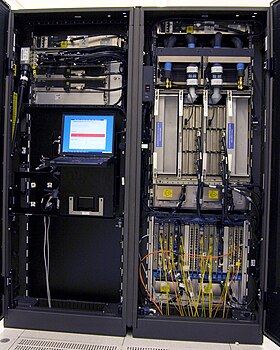Characteristics

Modern mainframes can run multiple different instances of operating systems at the same time. This technique of virtual machines allows applications to run as if they were on physically distinct computers. In this role, a single mainframe can replace higher-functioning hardware services available to conventional servers. While mainframes pioneered this capability, virtualization is now available on most families of computer systems, though not always to the same degree or level of sophistication.
Mainframes can add or hot swap system capacity without disrupting system function, with specificity and granularity to a level of sophistication not usually available with most server solutions.citation needed Modern mainframes, notably the IBM zSeries, System z9 and System z10 servers, offer two levels of virtualization: logical partitions (LPARs, via the PR/SM facility) and virtual machines (via the z/VM operating system). Many mainframe customers run two machines: one in their primary data center and one in their backup data center—fully active, partially active, or on standby—in case there is a catastrophe affecting the first building. Test, development, training, and production workload for applications and databases can run on a single machine, except for extremely large demands where the capacity of one machine might be limiting. Such a two-mainframe installation can support continuous business service, avoiding both planned and unplanned outages. In practice many customers use multiple mainframes linked either by Parallel Sysplex and shared DASD (in IBM's case),citation needed or with shared, geographically dispersed storage provided by EMC or Hitachi.
Mainframes are designed to handle very high volume input and output (I/O) and emphasize throughput computing. Since the late 1950s,NB mainframe designs have included subsidiary hardwareNB (called channels or peripheral processors) which manage the I/O devices, leaving the CPU free to deal only with high-speed memory. It is common in mainframe shops to deal with massive databases and files. Gigabyte to terabyte-size record files are not unusual. Compared to a typical PC, mainframes commonly have hundreds to thousands of times as much data storage online, and can access it reasonably quickly. Other server families also offload I/O processing and emphasize throughput computing.
Mainframe return on investment (ROI), like any other computing platform, is dependent on its ability to scale, support mixed workloads, reduce labor costs, deliver uninterrupted service for critical business applications, and several other risk-adjusted cost factors.
Mainframes also have execution integrity characteristics for fault tolerant computing. For example, z900, z990, System z9, and System z10 servers effectively execute result-oriented instructions twice, compare results, arbitrate between any differences (through instruction retry and failure isolation), then shift workloads "in flight" to functioning processors, including spares, without any impact to operating systems, applications, or users. This hardware-level feature, also found in HP's NonStop systems, is known as lock-stepping, because both processors take their "steps" (i.e. instructions) together. Not all applications absolutely need the assured integrity that these systems provide, but many do, such as financial transaction processing.citation needed
Comments
Post a Comment